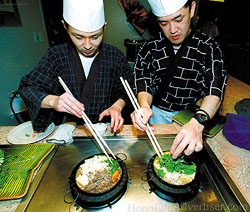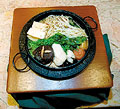|
A chef describes the sauce as "more flavorful, but subtle and mild" in Osaka-style sukiyaki. The meat is cooked early in the process.
In the Tokyo-style sukiyaki, the broth is made first and the beef cooked in afterward. The sauce is deeper in color but lighter in taste.
While it’s still a little cool, it’s time for sukiyaki.
The traditional nabemono or one-pot dish of Japan, comprised of beef, vegetables and tofu cooked in a soy-based sauce, is wholesome and hearty, not to mention delicious.
"It is a winter dish in Japan," according to Nozomu Iwasaki, executive chef of Kosoji Kukiyaki and Shabu Shabu Restaurant in Tokyo. "The family gathers round the sukiyaki pot to warm up; it is not an individual dish but a communal one."
Iwasaki is a guest chef at the Ala Moana Hotel’s Plantation Cafe along with Kenichi Mizutani, executive chef of Nadaman Japanese Restaurant chain in Osaka. Both are participating in the Cafe’s Sukiyaki Festival going on through March 24.
Sukiyaki is a simple dish to prepare at home: a portable burner with a heavy low-sided pot for cooking in the center of the table or an electric skillet will do nicely. Assemble the ingredients and let everyone participate in the cooking. But will it be Osaka-style or Tokyo-style sukiyaki that you prepare?
Mizutani, a specialist in Osaka-style cooking with a government license and 24 years of cooking experience, characterizes his sukiyaki as having a "more flavorful sauce but subtle and mild" when compared to Tokyo-style sukiyaki.
Iwasaki holds a license, too, and has 12 years in the kitchen as a practitioner of the Edo- or Tokyo-style of cooking. In his sukiyaki, beef can be rare and the overall dish has a stronger flavor throughout.
Same cooking pot, same ingredients. The difference is in the order of cooking the ingredients.
But first a little sukiyaki background. "Suki" refers to a plow or the blade of an axe-like implement made of cast iron. "Yaki "means to cook over a grill or broiler."
Folklore says that cooks didn’t want to use their cooking pots to cook beef, so they would use the blade of a plow for a grill. Today, shallow cast-iron pans are used especially for this dish, thick at the bottom to maintain even heat, with rings at the side for handling the hot pot.
Beef is the defining ingredient of the dish. Before the 1860s, beef was not a part of the Japanese diet; for centuries it was considered counter to Buddhist tradition, which did not allow four-footed animals to be killed, according to Shizuo Tsuji in "Japanese Cooking: A Simple Art" (Kodansha International, 1980).
When Western traders and diplomats began to establish residency in Japan, cows were slaughtered for their tables. In the Meiji period, 1868-1912, sukiyaki became popular, as people wanted to experience all things foreign.
While local diners will find sukiyaki made with chicken, throughout Japan it is generally made with thinly sliced, well-marbled beef, except for Hokkaido, where lamb might be used.
The sauce is a mixture of soy, sugar, sake (rice wine), mirin (sweet rice wine) and dashi (stock made of seaweed and shaved bonito fish). Achieving a salty-sweet balance is important.
"The sauce is too strong for seafood," pointed out Iwasaki through interpreter Sammy Hirota, executive sous chef at the Ala Moana Hotel. "If made with seafood, more dashi would be added to dilute the soy sauce."
Regional and seasonal vegetables are part of the dish. The basics could include shungiku (chrysanthemum leaves), trefoil, mizuna, hakusai (won bok or Chinese cabbage) or bok choy. Shirataki, filaments of a starchy root known as devil’s tongue or amorphophalus konjac, are always present in sukiyaki, soaking up the flavors of the sauce.
Mushrooms - fresh shiitake, enoki and seasonal matsutake - also absorb the salty-sweet sauce well as do yaki tofu (grilled tofu) and yaki fu (wheat flour croutons). Green onions lend their color and flavor.
Finally a raw egg is always served with sukiyaki. Bite-sized morsels of sukiyaki are dipped into a beaten egg before being consumed; the heat of the morsel cooks the egg. "The egg makes it smooth and makes the flavor more mild," explained Iwasaki.
Now here’s how the chefs prepare it.
In the Tokyo-style sukiyaki, the cast-iron pan is heated and oiled brie3/4y with a piece of beef fat for flavor. The sauce ingredients - soy, dashi, mirin, sake, sugar - are added to the pan and brought to a boil. Then the vegetables are added, one by one, soaking up the flavors of the sauce. Finally when the vegetables are half-cooked, the meat is added and cooked to your liking.
For Osaka- or Kansai-style sukiyaki, a piece of beef fat is used to oil the pan and then the thin pieces of well-marbled beef are added. Sugar is sprinkled over the meat, caramelizing in the hot pan along with the meat. Sake is added next and brought to a boil. Then vegetables are placed in the pan, followed by the soy sauce and dashi or perhaps water. The mixture is brought to a boil until the vegetables are cooked.
Same pan, same ingredients, same length of cooking time. But a different taste. Mizutani’s sukiyaki had an overall milder flavor but revealed a little more depth in the sauce itself. The individual ingredients in Iwasaki’s version had a stronger flavor because they had cooked in the sauce.
There are many other subtle differences between Osaka- and Tokyo-style cooking, according to the visiting chefs.
In Osaka, usukuchi soy, a lighter colored, thin soy sauce is used, but it actually has more flavor than dark soy sauce, Mizutani said. Koikuchi, a dark soy sauce, is typical of Tokyo-style cooking, deeper in color but lighter in taste.
"In Tokyo, tuna or red fish is considered the best," Iwasaki said. "In Osaka, white fish like turbot and red snapper are prized."
Sushi is different in the two cities. Hand sushi is prominent in Tokyo, but in Osaka, fish is marinated, placed atop a block of rice, pressed and then sliced into individual pieces.
Naga negi, or long onions, a relative of the green onion but much thicker and longer, is a key ingredient in Japanese cookery. "The white part is more important in Tokyo, the green part in Osaka and Kyoto; the city of Nagoya in between uses a little of each part," Iwasaki said.
Red miso is preferred in Osaka, white in Kyoto. Tokyo uses a brown or mixed colored miso.
But one key food both chefs agree on is rice, the main course of the Japanese table and a natural accompaniment to sukiyaki. Koshihikari is best, according to the visiting chefs. This variety is referred to as sushi rice; it is sticky and short-grained with a nice sheen when cooked. It is a rice variety now grown in California and available at Marukai.

 |
| Visiting chefs Kenichi Minitani from Osaka, Japan, left, and Nozomu Iwasaki from Tokyo will show Islanders the difference between Osaka-style sukiyaki, left, and Tokyo-style sukiyaki. Both styles use the same ingredients, but they are cooked in different order.
Gregory Yamamoto • The Honolulu Advertiser |
Recipes for two sukiyaki styles
Chefs Nozomu Iwasaki and Kenichi Mizutani will be preparing single portions of sukiyaki for diners during the Sukiyaki Festival at the Ala Moana Hotel’s Plantation Cafe. We have adjusted their recipe to serve four, approximating the measurements. The quantity of each ingredient can be adjusted to your taste.
Dashi is Japanese stock, made from shaved bonito (katsuo) and konbu (dried kelp). It can be made from scratch or is available in "instant" powdered form.
In Osaka-style sukiyaki, 3/4 cup of dashi is called for. In Tokyo-style sukiyaki, the 3/4 cup of dashi is further enhanced by powdered dashi and water, creating a stronger flavored stock.
Sukiyaki
- 1 1/2 pounds beef, thinly sliced
- 2 ounces beef fat back
- 1 bunch green onions, cut into 1 1/2 inch lengths
- Approximately 8-10 cups of mixed vegetables: chrysanthemum leaves, won bok, baby bok choy
- 8 shiitake mushrooms
- 4 ounces enoki mushrooms
- 10 ounces yaki tofu or firm tofu, cut into 11/2 inch cubes
- 8 ounces shirataki
- 12 pieces yaki fu or kohanafu (wheat flour croutons)
- 4 eggs
Sauce:
- 1/2 cup soy sauce
- 1/4 cup sugar
- 1/2 cup sake (rice wine)
- 1/2 cup mirin (sweet rice wine)
- 3/4 cup katsuo dashi (bonito stock)
- 3/4 cup water (for Tokyo-style recipe only)
- 1 teaspoon powdered katsuo dashi (for Tokyo-style recipe only)
Osaka style
Heat a cast-iron skillet or other heavy pan over medium-high heat. When pan is hot, rub the beef fat around the pan, allowing the melting fat to coat the pan well. Add beef and sear; sprinkle sugar over meat as you move the meat around the pan. When the meat is nicely browned, add the sake. Add the vegetables, arranging them in neat bunches within the pan. Add soy sauce and dashi; bring to a boil. Turn vegetables, mushrooms and tofu in sauce as it boils. Continue to boil until vegetables are done. Serve immediately with hot rice and raw egg on side.
Tokyo style
Heat a cast-iron skillet or other heavy pan over medium-high heat. When pan is hot, rub the beef fat around the pan, coating lightly. Add all the sauce ingredients plus additional 3/4 cup water and powdered katsuo dashi and bring to a boil for 2-3 minutes. Place vegetables in pan, arranging them in neat bunches. When vegetables are cooked halfway (turn items in sauce), add beef. Bring back to a boil and cook beef according to personal preference. Serve with hot rice and with raw egg for dipping.
[back to top] |

 The Great Index to Fun
The Great Index to Fun



